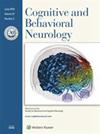Verbal and Nonverbal Memory in Neurodegenerative and Stroke Aphasia: Evidence From the Turkish Version of the Three Words Three Shapes Test
IF 1.3
4区 医学
Q4 BEHAVIORAL SCIENCES
引用次数: 0
Abstract
Background: Although language impairment is the most salient feature of cognitive impairment in both primary progressive aphasia (PPA) and stroke aphasia (SA), memory can also be impaired in both patient populations. Objective: To identify distinctive features of verbal and nonverbal memory processing in individuals with PPA and those with SA. Method: We gave individuals with PPA (n = 14), those with SA (n = 8), and healthy controls (HC; n = 13) a comprehensive neuropsychological test battery and the Turkish version of the Three Words Three Shapes Test (3W3S–Turkish). The 3W3S–Turkish Test includes five subtests: Copy, Incidental Recall, Acquisition, Delayed Recall, and Recognition. High-resolution brain scans were performed in a subset of individuals with PPA and those with SA. Lesion distribution was limited to the dorsal language areas in the SA group, whereas peak atrophy areas in the PPA group extended beyond the language network, including the medial temporal lobe, precuneus, and posterior/medial portions of the cingulate cortex. Results: Both the PPA and SA groups showed impairment in incidental recall, and the PPA group showed additional impairment in delayed recall. Greater impairment for verbal stimuli suggestive of material-specific memory impairment was evident in the PPA group’s scores on the Incidental Recall and Delayed Recall subtests. Both aphasia groups retained the acquired information regardless of material type. Conclusion: Although both aphasia groups shared similarities in the involvement of the dorsal prefrontal working memory/attention network, the PPA group showed greater impairment in delayed recall compared with the SA group.神经退行性和中风失语症的言语和非言语记忆:来自土耳其语三词三形测验的证据
背景:虽然语言障碍是原发性进行性失语症(PPA)和卒中性失语症(SA)中认知障碍的最显著特征,但在这两种患者群体中,记忆也可能受损。目的:探讨PPA患者和SA患者言语和非言语记忆加工的特点。方法:选取PPA患者(n = 14)、SA患者(n = 8)和健康对照(HC;n = 13)综合神经心理测试组和土耳其版的三字三形测试(3w3s -土耳其语)。3w3s -土耳其测试包括五个子测试:复制、附带回忆、习得、延迟回忆和识别。对PPA患者和SA患者进行了高分辨率脑部扫描。SA组的病变分布仅限于背侧语言区,而PPA组的峰值萎缩区域延伸到语言网络之外,包括内侧颞叶、楔前叶和扣带皮层的后/内侧部分。结果:PPA组和SA组在偶然回忆中均表现出障碍,PPA组在延迟回忆中表现出额外的障碍。PPA组在附带回忆和延迟回忆子测试中的得分明显显示,言语刺激对物质特异性记忆障碍的损害更大。两组失语症患者均保留了习得的信息,与材料类型无关。结论:尽管两组失语症患者在背侧前额叶工作记忆/注意网络的参与上有相似之处,但PPA组在延迟回忆上的损害大于SA组。
本文章由计算机程序翻译,如有差异,请以英文原文为准。
求助全文
约1分钟内获得全文
求助全文
来源期刊
CiteScore
2.40
自引率
7.10%
发文量
68
审稿时长
>12 weeks
期刊介绍:
Cognitive and Behavioral Neurology (CBN) is a forum for advances in the neurologic understanding and possible treatment of human disorders that affect thinking, learning, memory, communication, and behavior. As an incubator for innovations in these fields, CBN helps transform theory into practice. The journal serves clinical research, patient care, education, and professional advancement.
The journal welcomes contributions from neurology, cognitive neuroscience, neuropsychology, neuropsychiatry, and other relevant fields. The editors particularly encourage review articles (including reviews of clinical practice), experimental and observational case reports, instructional articles for interested students and professionals in other fields, and innovative articles that do not fit neatly into any category. Also welcome are therapeutic trials and other experimental and observational studies, brief reports, first-person accounts of neurologic experiences, position papers, hypotheses, opinion papers, commentaries, historical perspectives, and book reviews.

 求助内容:
求助内容: 应助结果提醒方式:
应助结果提醒方式:


